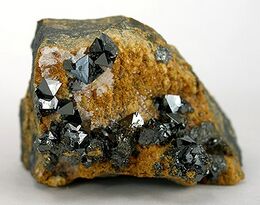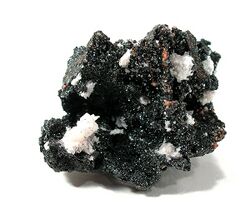Chemistry:Jacobsite
From HandWiki
| Jacobsite | |
|---|---|
 | |
| General | |
| Category | Oxide minerals Spinel group Spinel structural group |
| Formula (repeating unit) | iron(II,III) manganese oxide, (Mn,Mg)Fe2O4 |
| Strunz classification | 4.BB.05 |
| Crystal system | Isometric |
| Crystal class | Hexoctahedral (m3m) H-M symbol: (4/m 3 2/m) |
| Space group | Fd3m (no. 227) |
| Unit cell | a = 8.457 Å; Z = 8 |
| Identification | |
| Color | Black to brownish black |
| Crystal habit | Disseminated to massive, rarely as octahedral crystals |
| Twinning | Spinel law, flattened on {111} or lamellar |
| Cleavage | {111}, probably a parting |
| Fracture | Conchoidal |
| Mohs scale hardness | 5.5–6.5 |
| |re|er}} | Metallic |
| Streak | reddish black to brown |
| Diaphaneity | Opaque |
| Specific gravity | 4.76 |
| Optical properties | Isotropic |
| Refractive index | ~2.3 |
| Other characteristics | weakly magnetic |
| References | [1][2] |
Jacobsite is a manganese iron oxide mineral. It is in the spinel group and forms a solid solution series with magnetite. The chemical formula is (Mn,Mg)Fe2O4 or with oxidation states and substitutions: (Mn2+,Fe2+,Mg)(Fe3+,Mn3+)2O4.[1][4]
It occurs as a primary phase or as alteration of other manganese minerals during metamorphism of manganese deposits.[4] Typical associated minerals include hausmannite, galaxite, braunite, pyrolusite, coronadite, hematite and magnetite.[1] It is a ferrimagnetic substance, which is weakly attracted by a magnet.
It was first described in 1869 and named for the Jakobsberg Mine, Nordmark, Filipstad, Värmland, Sweden.[2]
References
- ↑ 1.0 1.1 1.2 Handbook of Mineralogy
- ↑ 2.0 2.1 Mindat.org
- ↑ Warr, L.N. (2021). "IMA–CNMNC approved mineral symbols". Mineralogical Magazine 85 (3): 291–320. doi:10.1180/mgm.2021.43. Bibcode: 2021MinM...85..291W.
- ↑ 4.0 4.1 Webmineral data
 |


